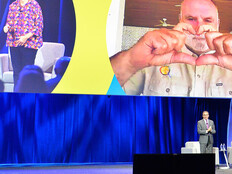The process would have taken three months under normal circumstances, says Dr. Rebecca Mishuris, the organization’s associate chief medical information officer. Within another week, the hospital was piloting a video visit program using Zoom.
Still, limitations of the hospital’s patient population led BMC clinicians to focus on telephone visits. “We know almost all of our patients have phones, but many don’t have a smartphone or a computer or internet connectivity,” Mishuris says.
Ramping Up a Training Program for Virtual Care
For Jefferson Health, the primary challenge for ramping up telehealth adoption wasn’t the equipment or infrastructure.
The Philadelphia organization already had a robust on-demand platform, numerous inpatient telehealth programs and a “tele-triage” system in its emergency department, which uses videoconferencing as a first point of contact with some incoming patients.
The system also had plenty of iPad devices earmarked for other projects that were instead configured for the COVID-19 response. In addition, the hospital worked to develop an online chatbot so patients could check their symptoms from home and rolled out a remote monitoring program for discharged COVID-19 patients.
But many more providers, some of whom used smartphones to deliver care, needed to be educated — and fast.
“It’s never about the technology,” says Dr. Aditi Joshi, medical director for JeffConnect, Jefferson Health’s telehealth program. “You need the connection and you need to communicate. You need the staffing and the process. That’s a bit harder.”
That’s why Joshi and her colleagues pivoted in mid-March to shift telehealth training from a small-scale, in-person model to an online program with a Zoom webinar and a Microsoft SharePoint documentation portal.
The online modules enabled Jefferson to train 700 providers in scheduled visits and 160 providers in on-demand visits in a three-day span, says Dr. Judd Hollander, senior vice president for healthcare delivery innovation at Jefferson.
As a result, the system transitioned from 200 virtual visits per day to 3,000, with 90 percent of all visits completed via telehealth and 70 percent of patients with previously scheduled visits able to keep their appointments.
“From day one, we said, ‘Let’s not ignore the non-COVID patients,’” Hollander says.
DISCOVER: Learn how organizations deliver telehealth to rural and high-risk patient populations.
Preparing for the Future of Telehealth
Despite the ongoing momentum, experts agree the current state of telehealth use will change post-COVID-19. The HIPAA waiver will expire, meaning that health systems won’t be able to use consumer products such as FaceTime and Skype for video visits. (Microsoft Teams and Zoom for Healthcare are HIPAA-compliant.)
Insurance coverage is another unknown. What had previously been an “ongoing and slow process” to changes in reimbursement will likely continue, Lennox-Miller says, especially now that Medicare is on board.















